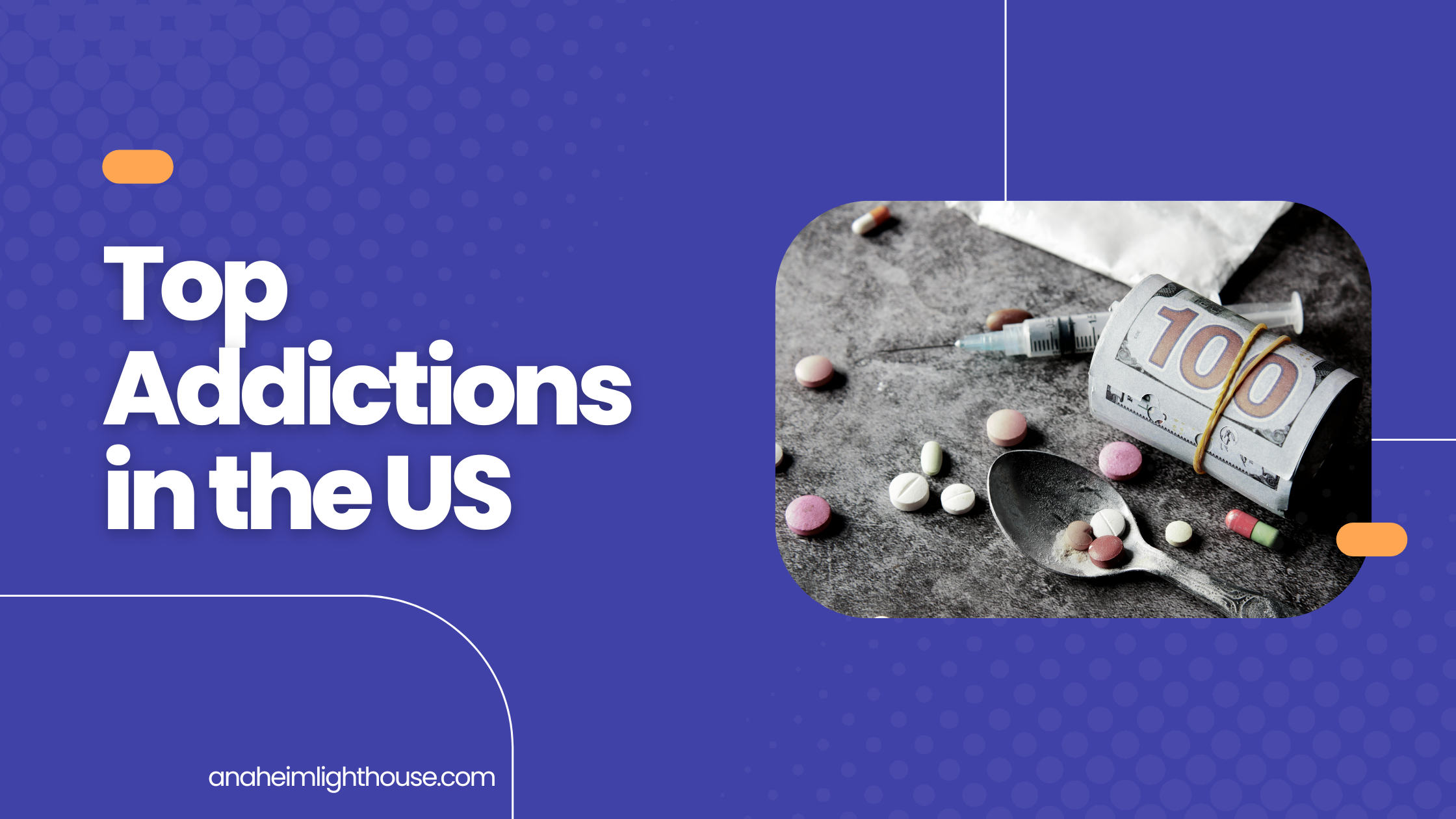Top Addictions In The US
In the United States, a huge percentage of the general population is abusing substances and alcohol due to various reasons like leisure and stress. These common addictions are destroying many lives of individuals and families all over the country, and this problem requires urgent attention.
Among different medical studies in the U.S., the top five addictions in the general population are alcohol, nicotine, caffeine, illicit drugs, and prescription medicines. Some of these substances are regulated, while some are not.

In this article, we will talk about the top five addictions in the United States, their effects on human health, and treatment options.
1. Alcohol Addiction
Alcohol use disorder (AUD) is a chronic relapsing brain disease characterized by compulsive alcohol seeking and use, even when faced with negative consequences. While occasional drinking is generally considered safe, heavy drinking and binge drinking can lead to alcohol dependence.
Millions of Americans suffer from AUD, and it is estimated that about 15 million people in the United States have an alcohol use disorder.
Below are the following symptoms of alcohol use disorder:
- High tolerance leading to larger consumption of alcoholic beverages
- Continued drinking despite its negative impact on relationships with friends and families
- Inability to meet deadlines and tasks for school and work
- Insatiable desire to drink almost every day
- Inability to stop drinking no matter how hard you try
2. Nicotine Addiction
Nicotine is a highly addictive substance that is derived when a person smokes tobacco and inhales it from its nostrils up to its lungs and brain. The nicotine compound exudes a pleasurable feeling in the brain of the user. Generally, it elevates the mood of any person.
The major downside of continued smoking is the higher chance of developing critical illnesses like cancer, heart attack, and stroke.
Here are some typical risk factors which induce nicotine addiction:
- Environment: It is most likely that an individual is most likely to get addicted to tobacco or nicotine when some family members are smoking as well.
- Age: People who start smoking at an early age have the highest chance of developing nicotine addiction due to the tolerance developed from smoking at an early age.
- Social Media: The content shown on various social media platforms greatly influences the lifestyle of all individuals. If a person is frequently exposed to social media showing that smoking tobacco is a lucrative status symbol, there is a higher risk for nicotine addiction to occur.
- Depression and the Presence of Mental Disorders: Studies show that people experiencing depression or those diagnosed with mental disorders are usually smokers.
Determining if someone is addicted to tobacco or smoking is easy when you observe some of these telltale signs:
- Smoking tobacco even when driving
- Presence of a cigarette smell on the person’s clothing
- Binge eating while smoking
- Smoking and drinking at the same time
- Frequent or at least three times a day of smoking cigarettes
The worst side effects of smoking nicotine can be seen in the long run. Some of the worse long-term side effects of nicotine abuse include:
- Heart disease
- Lung cancer
- Chronic asthma
- Emphysema
- Eye-related diseases
- Bronchitis
Aside from tobacco cigarettes, another source of nicotine is vaping. Vaping has increasingly become popular among teenagers and young adults. Vaping is the act of inhaling and exhaling an aerosolized liquid that usually contains nicotine, propylene glycol, and flavorings.
While vaping is marketed as a “safer” alternative to smoking cigarettes, it still poses several risks to the user’s health. Many vape users are unaware that vaping devices still contain nicotine.
3. Caffeine Addiction
Caffeine is one of the non-regulated addictive substances that can cause addiction when tolerance is built-up in the system. Common sources of caffeine include tea, chocolate, coffee, soft drinks, and energy drink supplements. Determining if a person is addicted to caffeine is highly challenging because of the wide acceptance of this beverage.
According to research, the required minimum amount of caffeine daily intake is 100 mg. A safer lower dose is between 60 to 85 mg daily. While caffeine addiction is not as serious as drug addiction or alcohol addiction, it can still lead to serious side effects.
Some side effects include sleep disorders, faster heart rate, nervousness, anxiety, being highly irritable, uncontrolled speech when in rage, and other health problems.
4. Illicit Drugs
Most substances under this type alter the central nervous system where it can either elevate or depress the activity of your brain and perceptions. It also induces a psychedelic impact on one’s perception of sound and shape.
Below are the various kinds of illicit drugs often abused:
Cocaine
This is also commonly known as “Coke” where it is medically applied as anesthesia. Coke is taken in various ways such as by smoking, rubbing on the gum areas, snorting, and intravenous application.
When a person abuses this cocaine or crack cocaine, it exudes a euphoric feeling, heightened senses, and a happy mood. The long-term adverse effects of cocaine include Parkinson’s disease, hallucinations, paranoia, and nutrition.
Heroin
This illicit substance is medically used for relieving pain. It is under the class of opiate drugs, where it is known for the chemical names of Diacetylmorphine and Diamorphine. Heroin is morphine-derived, the main reason why it can alleviate pain.
Users abuse this drug and develop heroin addiction because of the euphoric feeling it induces as it kicks inside the system. When taken at a higher dose, it can intoxicate the body and cause irreparable damage to the brain.
Methamphetamine
This narcotic illicit drug is also called meth which has a primary function of increased brain activity. When this substance reaches the central nervous system, it excites the neurotransmitters or brain messengers which gives that euphoric feeling and intense mental alertness.
Some of the common side effects of meth addiction include uncontrollable anger, reduced self-awareness, inability to sleep properly, unstable mood, and behavior. Moreover, a continued overdose of meth can also produce mental disorders in the future.
Weed
The active component of weed or marijuana is the delta-9-tetrahydrocannabinol (THC). This active ingredient is responsible for altering the mood and thinking of the user. The worst long-term effect of weed addiction is a great reduction in IQ and brain degeneration.
5. Prescription Drugs
Intoxication with prescribed substances has increased dramatically over time due to its unnoticeable abuse due to its medicinal impact. The three most commonly abused prescription drugs include stimulants, antidepressants, and opiates or pain relievers.
It is expected that the intake of these medicines is only for a specific time frame due to their adverse effects and possible development of tolerance. Addiction to these medications also happens when the patient ingests other substances to amplify the effects of these medicines.
Contact the Best Addiction Rehab in Southern California
Struggling with addiction, especially to illicit drugs and alcohol, can be extremely difficult to deal with. However, professional help is available to address this problem.
Reach out today to speak to an addiction treatment specialist. We can discuss your unique situation and help you find the best treatment options available.















